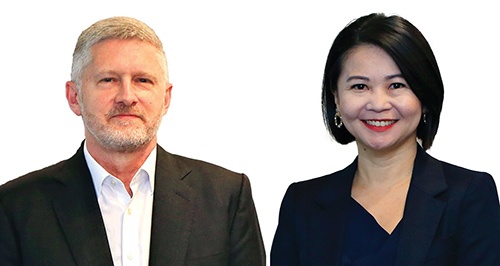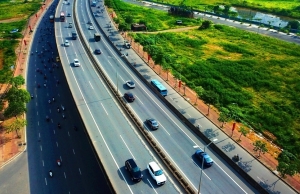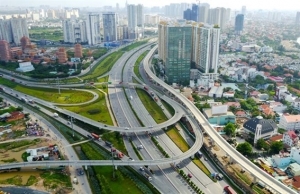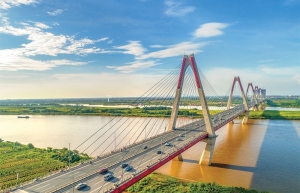Flexibility desired for infrastructure
 |
| Richard Abadie, partner and leader of Global Capital Projects & Infrastructure at PwC; and Jennifer Tay, partner and leader of Infrastructure at PwC Singapore |
What should Vietnam adopt in order to effectively augment its allure as a destination towards robust infrastructure investments?
Abadie: The question of how to attract more investment in infrastructure is a complex one, requiring attention to a range of factors.
One key aspect is the establishment of open markets, particularly with regard to the free flow of capital. When a country aims to entice overseas funding, it must create conditions that facilitate the unrestricted movement of money.
While legislation allowing limitations on the ownership of strategic assets exist in various countries, such as the UK and Australia, these constraints need not impede Vietnam’s progress, provided the process remains transparent and the rules are clearly understood.
It is essential for both the investing and recipient countries to maintain stability and confidence as ownership changes can significantly impact the underlying fundamentals.
The current focus on Vietnam’s economy has prompted concerns about financing infrastructure projects. Allocating funds wisely is a critical consideration, and decisions regarding expenditure must be carefully evaluated. For instance, the question arises as to whether investing approximately $60 billion in connecting the north and south of the country represents the optimal utilisation of limited resources.
While transport assets and connectivity are undoubtedly important, it is worth contemplating whether high-speed rail, which primarily caters to passenger transport rather than freight, should receive priority investment in a country as geographically elongated as Vietnam. Other areas, such as energy infrastructure, telecommunication infrastructure, and coastal developments, may hold greater significance.
Meeting the infrastructure needs of Vietnam’s sizable population is a compelling investment proposition, particularly when it comes to critical aspects like housing, water, and power.
Another positive aspect worth highlighting is Vietnam’s prudent management of its debt-to-GDP ratio, which currently stands at 43.1 per cent. Unlike countries facing significant debt burdens that act as constraints, Vietnam’s comparatively lower debt level presents an opportunity to attract private capital and collaborate with government entities on projects.
However, it is essential to address specific project-related challenges, such as credit rating and debt-to-GDP limits. While these conditions may pose certain difficulties, they can also be viewed as opportunities.
In today’s financial markets, where investors seek the best risk-return opportunities, it is crucial to compete effectively for capital and investments. The challenge lies in navigating the complexities associated with public-private partnerships and ensuring openness in risk-sharing arrangements.
While there have been improvements in related laws in Vietnam, further progress is necessary to foster an environment of transparency and risk allocation. Continuous reflection on risk and the evolution of appropriate frameworks are vital to attract investors. Additionally, environmental, social, and governance (ESG) factors have become increasingly important for global finance. As Vietnam seeks overseas funds, financiers will inevitably scrutinise the environmental sustainability, social impact, and governance of projects. Consequently, requesting foreign capital will come with certain requirements that can positively influence governance practices and ensure thorough project evaluation. Vietnam needs to enhance its capabilities and tools to conduct comprehensive assessments and report on outcomes, as the integration of ESG considerations has become a global trend in financial decision-making.
 |
| Flexibility desired for infrastructure, illustration photo |
What illustrative instances exemplify the multifaceted and divergent governmental perspectives on strategic allocations in infrastructure funding?
Tay: I recently engaged in a stimulating conversation about one nation’s attempt to replicate Singapore’s fibre optics network and its successful business model. As we delved deeper, examining why Singapore’s model thrived and the requisite conditions for success in Southeast Asia, we discovered that replicating the business model alone was insufficient.
Singapore boasts a robust regulatory framework governing tariffs within its broadband network. Each country, however, possesses its own distinct legal and regulatory frameworks. When foreign investors enter the scene, the endeavour often involves structuring contracts to fit those local legal and regulatory frameworks.
By incorporating these frameworks into contracts, a certain degree of flexibility emerges, allowing for effective asset management and regulation. Therefore, I agree with Richard’s assertion that asset ownership need not be limited to the binary choice of public or private.
Such an approach fails to acknowledge that, with proper regulation, privatised assets can still be subject to oversight. When I have encountered governments across Southeast Asia, I have noticed a tendency to employ a copy-and-paste strategy, replicating models without considering the need for adaptability in the regulatory structures. It is imperative to consider the entirety of the package, not merely the business or ownership structure.
On the other hand, the prevailing assumption that assets can only be either public or private is misleading. The key factor lies in effective regulation regardless of ownership. The regulatory body must possess independent authority, responsible for governance and oversight on health, safety, and customer charges. Even in cases where assets are publicly owned, an independent regulator should oversee these aspects.
It is essential to prioritise infrastructure based on citizens’ needs, with ownership serving as a secondary consideration. Investment in state assets can be facilitated by the private sector through concessions and other collaborative arrangements.
Abadie: Examining the disparity in governmental perspectives on this matter, the British government for example exhibits a highly receptive stance towards foreign investors, particularly in the water and energy sectors. Their openness manifests in their concerted efforts to allure foreign capital for infrastructure projects.
A few years ago, a significant shift occurred with the privatisation of the water sector. I recall a momentous occasion in the 2000s when we deliberated the sale of three vital transport assets based in London: Heathrow Airport, a bypass around the city, and securing investments for the underground network. Remarkably, all prospective bidders for these projects were international entities such as Qatari and Saudi companies, Australian infrastructure funds, and Canadian counterparts.
In a discussion with people within government, I inquired about any reservations or limits regarding the privatisation of these assets. The response was rather reassuring, as they emphasised that the regulated industry engendered confidence. The government did not interfere in making such decisions; instead, they had historically privatised or sold assets while maintaining stringent regulations. The regulator held the authority to determine appropriate owners for the capital spending programme and set tariffs.
Reflecting on Vietnam, a market I am not intimately familiar with, it appears that public or private ownership is often perceived as mutually exclusive, for example in toll road ownership structures. However, the pivotal factor lies in how assets are regulated. Ownership is not a prerequisite for ensuring optimal asset performance, protecting health and safety, or regulating tariffs.
Therefore, we must question the economic models in place and consider who they aim to safeguard. Going to either extreme, relying solely on public or private approaches, tends to yield suboptimal outcomes. In my experience, I would encourage you, as I would in any other market, to explore robust regulatory models that ensure fair tariffs and returns. These models are typically rooted in a strong regulatory framework rather than hastily implementing ill-suited strategies.
On the flip side, throughout history, foreign investment has never entailed the removal of physical infrastructure or the dismantling of roads. However, an emerging concern that necessitates our attention is cybersecurity. Consider a scenario where the infrastructure is located in Vietnam, but the computers controlling its operations are situated elsewhere. This disparity in location could pose significant problems. Thus, it is crucial to comprehend not only the tangible physical aspects of infrastructure but also the underlying IT infrastructure, and its placement and management.
In light of Vietnam’s ambitious goal to achieve net-zero carbon emissions by 2050, the country has placed great emphasis on promoting ESG criteria. How would you recommend striking a balance between economic growth and sustainability in this pursuit?
Tay: The significance of Vietnam’s role within the region must not be underestimated when contemplating the intertwining of economic and sustainability objectives. Notably, Vietnam has positioned itself as a promising hub for manufacturing activities related to electric vehicles and batteries, thus leveraging its advantages in this sector. This perspective is crucial as it expands the understanding of Vietnam’s commitment beyond merely decarbonising its own operations.
Instead, it encompasses the country’s impact on the broader supply chain and its contribution to overall economic development of the region. Therefore, while achieving absolute zero emissions might not be the primary driver of economic growth, the manufacturing sector and its associated supply chain play a pivotal role in driving the economy forward.
Moreover, an intriguing avenue for collaboration lies in electricity trading. The region faces a significant disparity in the supply and demand of renewable energy, which can be addressed through collaborative efforts. It would be worthwhile to explore the potential benefits and Vietnam’s involvement in this context, considering how the bankability of renewable energy projects depends heavily on demand dynamics.
By capitalising on its manufacturing advantages and aligning with the demand for renewable energy, Vietnam can consolidate its position in the region and foster economic growth.
Furthermore, Vietnam possesses a unique advantage in the realm of renewable energy. The country enjoys abundant solar potential as well as better conditions for wind energy, a resource scarce in neighbouring countries such as Malaysia and Singapore. This presents Vietnam with an opportune platform to harness solar, wind, and even hydro energy, which could be exported to supplement regional energy needs.
Cultivating an indigenous industry for manufacturing wind turbines, solar panels, and related components domestically would prove not only financially rewarding but also strategically advantageous for Vietnam.
By deftly navigating the interplay between economic growth and sustainability, Vietnam can carve a path towards net-zero emissions while bolstering its standing in the region. This endeavour entails capitalising on the manufacturing sector, engaging in collaborative electricity trading initiatives, and exploiting its renewable energy potential. Such a holistic approach will empower Vietnam to thrive economically and contribute meaningfully to the global sustainability agenda.
 | ASEAN+3 should unlock more capital for sustainable infrastructure COVID-19 has brought severe hardships to peoples and communities across the globe, but for the economies of the Association of Southeast Asian Nations, a resilient recovery is underway. |
 | PPP model needs more balancing, equality for private investors Vietnam's increased demand for infrastructure development in the coming years requires governmental policies that encourage the private sector's participation, said economists and policymakers. |
 | Resolving the remaining issues in infrastructure investment I first came to Vietnam when the US embargo on Vietnam was lifted in February 1994. Freshfields decided to open an office in Vietnam to focus on infrastructure development and foreign investment work. At the time, Vietnam’s electricity supply was inadequate. |
What the stars mean:
★ Poor ★ ★ Promising ★★★ Good ★★★★ Very good ★★★★★ Exceptional
Related Contents
Latest News
More News
- Vietnamese firms step up ESG game (September 23, 2025 | 15:26)
- Vietnam tax and legal changes set to shape foreign investment landscape (September 16, 2025 | 13:46)
- Vietnamese businesses navigate US tariffs (June 25, 2025 | 12:14)
- The impact of cloud, AI, and data on financial services (April 14, 2025 | 11:20)
- Vietnam 2025 M&A outlook: trends, deals, and opportunities (March 21, 2025 | 08:54)
- Vietnam's M&A landscape mirrors global trends (February 18, 2025 | 17:13)
- Asia-Pacific CEOs enter 2025 with optimism and caution (February 06, 2025 | 17:16)
- Proposed changes to interest deductibility rules may be welcomed by taxpayers (January 22, 2025 | 09:23)
- PwC Vietnam holds Hack A Day 2024 to nurture IT and cybersecurity talents (November 14, 2024 | 12:24)
- VAA officially implements International Financial Reporting Standards (October 17, 2024 | 17:20)

 Tag:
Tag:





















 Mobile Version
Mobile Version